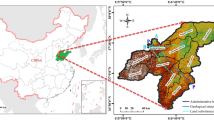Abstract
The smectite dehydration theory developed by Ransom and Helgeson was applied for simulation of land subsidence in the Yun-Lin coastal area, Taiwan. The volumetric reduction of smectite clay at equilibrium state was computed by assuming that the dehydration of interlayer water in smectite clay can be described with a regular solid solution reaction. By using the in situ stratigraphic data collected from the subsidence monitoring wells in the simulated area, the amounts of land subsidence caused by smectite dehydration in three scenarios with pressure variation were calculated. The results indicate that significant amounts of land subsidence can be attributed to smectite dehydration. This finding reveals that smectite dehydration is of importance for assessment and prediction of land subsidence. Additionally, the results also indicate the overburden weight has a larger effect on clay dehydration than the effective stress change resulting from over-pumping, although both of them induce relatively minor variations on land subsidence.
Similar content being viewed by others
Author information
Authors and Affiliations
Additional information
Received: 23 February 2000 · Accepted: 23 March 2000
Rights and permissions
About this article
Cite this article
Liu, CW., Lin, WS., Shang, C. et al. The effect of clay dehydration on land subsidence in the Yun-Lin coastal area, Taiwan. Environmental Geology 40, 518–527 (2001). https://doi.org/10.1007/s002540000193
Issue Date:
DOI: https://doi.org/10.1007/s002540000193




